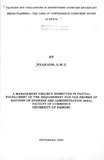| dc.description.abstract | This study was conducted between July and August, 2002. The population of interest included media planners working in Advertising Agencies in Kenyawho were members of the Association of Practitioners in Advertising. This study was a descriptive one with two main objectives, namely:
1. To determine whether the factors that are currently considered by advertising agencies in broadcast media planning are different from pre-liberalization.
2. To determine the challenges faced by advertising agencies in broadcast media planning.
A semi-structured questionnaire was used to collect data ( see Appendix 5). The findings were as follows:-
, -.
The factors that are considered by the advertising agencies in broadcast
media in order of importance currently and before liberalization include the following-:
The target audience has retained same favourability during both the pre- liberalization and post-liberalization periods. The budget has declined considerably in favour after liberalization.
Using factor analysis, before liberalization, two factors namely advertiser's marketing objectives which comprise audience demographics (.955), broadcast footprint (.908) and budgetary constraints (.869) and media house characteristics which comprise of reach (.932) and cost of media (.743) were extracted using varimax factor analysis.
After liberalization three factors namely target consumers which comprises of reach (.871) and audience (.819) and media house characteristics which comprised the cost of media (.912) and broadcast footprint (.814) and clients consideration which comprised budgetary constraints were extracted using varimax factor analysis.
From these analysis, reach and target audience are important factors considered in broadcast media planning currently, however budget constraints has lost favour currently probably due to increased competition
in the convenience consumer goods market in Kenya.
With regard to the second objective, the challenges facing media planners in broadcast media planning for convenience consumer goods are media budget constraints, measuring media effectiveness, clutter and the economic environment.
A factor analysis was carried and two factors namely, increase in media vehicles which comprised of waste (.936), increased costs (.973), clutter (.680), measuring media effectiveness (.634) and media proliferation (.502)
and Media Planner experience which comprises of purchasing cycle of buyers (.891), media selection (.851) and creativity (.640) were extracted using varimax factor analysis.
These factors could probably be due to increased media vehicles after liberalization of the broadcast media in Kenya. | en |

